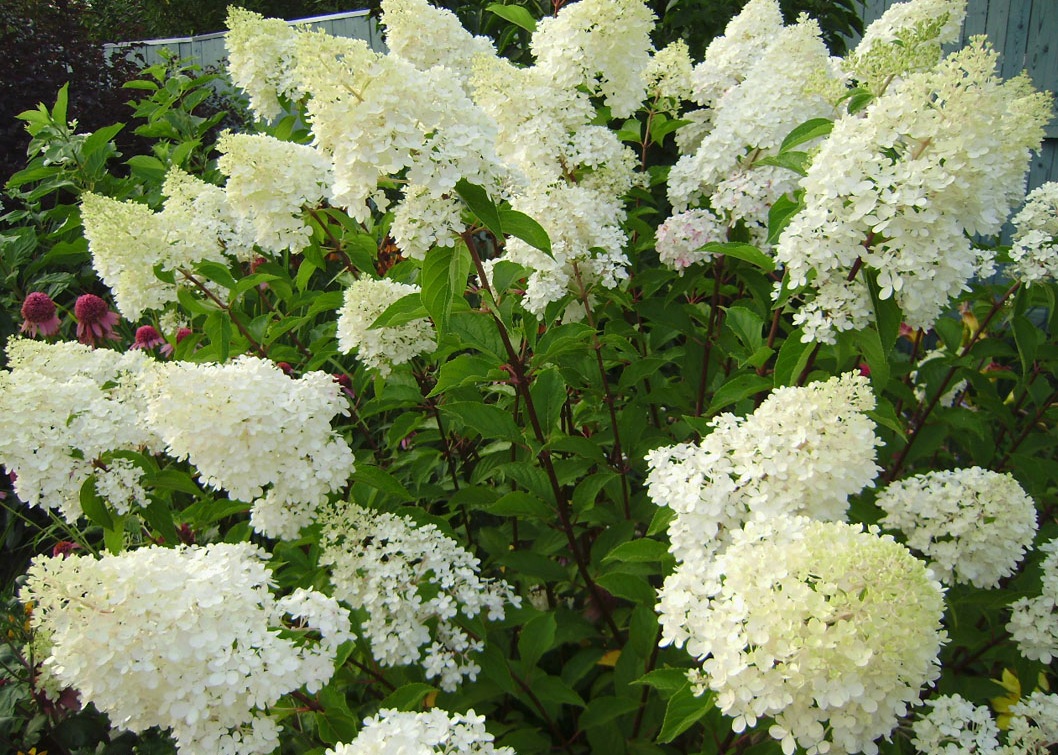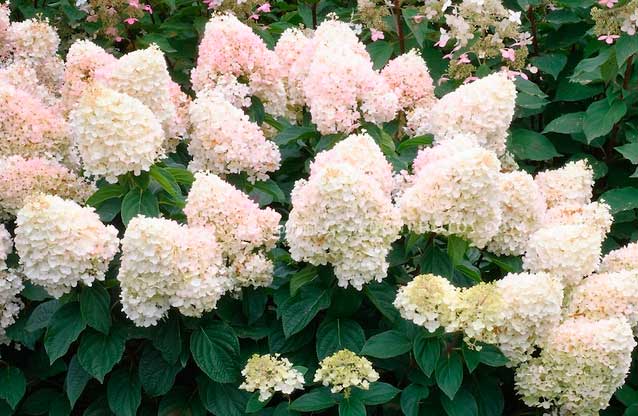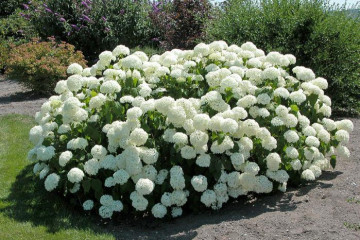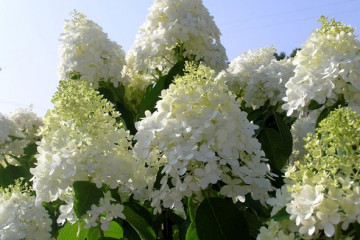Hydrangea Summer Snow (Summer Snow) - description
Content:
Hydrangea Summer Snow is a new addition to the Hydrangea family. She looks amazing, planted along the paths. Landscape designers recommend planting clematis, hosts and phloxes near perennials. This combination will give the flower bed a special appeal. Following the recommendations for care, you can grow healthy bushes, which will delight you with lush flowering every year.
Origin and appearance
Panicle hydrangea blooms throughout the summer. The plant usually fades in early October. Large flowers are white. Volumetric inflorescences give the bushes elegance. The shade of the flowers can change to light pink. The diameter of the inflorescences reaches 5 cm. The foliage of the plant is painted in a bright green hue.
Hydrangea Summer Snow is a medium-sized plant with a compact and neat appearance. According to these characteristics, the bushes are able to withstand frost, and when grown in the southern regions, they can be left to winter without shelter.
When planting seedlings, you should pay attention to the recommendations of experienced florists, who advise in the northern regions to choose planting places in areas illuminated by sunlight. In the southern region, it is worth choosing a more shaded landing site.
The variety is unpretentious and does not require complex care. No description of the Summer Snow hydrangea will convey all the charm of the plant during the flowering period.
Hydrangea transplant
Before purchasing a seedling, you must go to the garden to choose a place for planting. It is advisable to choose such a zone so that the plant is in the shade for the main period of time, but in the morning hours and after 16.00 the bushes are illuminated by the sun's rays. It is important to systematically moisten the soil around the planted perennials. It should also be borne in mind that in the southern region, seedlings planted in the open sun may die.
If there is a desire to create an alley of hydrangeas and plant bushes along the garden paths, then it is necessary to retreat from them about 90 cm and only in this place dig a depression. This will allow sprawling bushes to keep out of the way. If, nevertheless, the branches of the bush have gone beyond the boundaries of the path, it is worth tying them up with a rope.
Hydrangea is not planted close to the tree, as the plants will not be able to get enough nutrients. Soon one of them may not only get sick, but also die.
Soil for planting
The soil for planting should be loose and fertile. Summer Snow panicle hydrangea grows exclusively on slightly acidic ground. Experienced florists recommend preparing the planting recess in advance. This will allow you to independently create a slightly acidic substrate. For this purpose, it will be necessary to fill the pit by a third with sour brown peat. Also, a small part is added to the pit:
- sawdust of coniferous trees;
- forest soil;
- fertile soil;
- pine bark.
The size of the planting recess depends on the characteristics of the seedling.Experienced flower growers recommend digging a hole, the depth of which reaches 55 cm and the width does not exceed 60 cm.
Step-by-step planting process
- Without separating a clod of earth from the root system, rearrange the seedling in the planting recess.
- Fill up the formed voids in the pit with soil. In this case, the root collar should be located above the ground.
- Tamp the soil and pour the bush abundantly with two buckets of settled water. When the soil subsides after moistening, it is recommended to re-fill a small part of the earth. Compliance with this recommendation will allow you to get rid of air in the ground.
- The surface of the ground near the bush is mulched. A layer of high-moor peat and bark of conifers can be used as mulch. The recommended layer thickness is 6-7 cm.
Reproduction
It is not necessary to purchase young seedlings. You can grow them yourself. The Summer Snow hydrangea reproduces in several ways:
- cuttings;
- layering;
- dividing the bush.
To implement the first method, it is necessary to start cutting cuttings from the bush in the 20th of April. Preference is given to green shoots, the age of which does not exceed a year. The length of the cuttings should be at least 10 cm. When cutting the shoots, it is necessary to obtain a right angle. The foliage that is located below is removed.
In the cold season, the cuttings method can be carried out as follows:
- In the last days of October, dig up the parent bush and transplant it into a spacious container.
- Place the perennial in a room where the temperature does not drop below 6 ° C.
- By the end of winter, the shoots ripen, and cuttings can be cut from them (each should have two internodes).
- Trim the top green mass and cut off the bottom foliage.
- Treat the lower cut of each cutting with a growth stimulant.
- Plant blanks for seedlings in deep containers filled with nutritious soil. Cover the cuttings with jars.
Dividing the bush
Often, in order to obtain a seedling of the Summer Snow variety, flower growers use the method of dividing the bush. Having dug up the parent bush, you need to divide the perennial into several parts. Each division must contain a renewal bud. The resulting bush is planted in a prepared planting recess.
Layers
It is necessary to bend young shoots to the soil surface and dig them in. It is advisable to carry out the procedure in the 20th of October. The tops should remain on the surface of the ground. Their length should be 19-20 cm. Rooted shoots appear at the end of March. They must be separated from the bush and transplanted.
Care features
The first 12 months after planting, the hydrangea does not need special feeding. After a specified period of time, fertilizers are applied according to the schedule described below.
- In April, complex fertilizers should be applied under the Summer Snow hydrangea bushes, which contain trace elements and macronutrients. An excellent option in this case would be nitrogen and phosphorus.
- At the end of May, top dressing is introduced, consisting of potassium sulfate and superphosphate. This will make it possible to increase the size of the forming buds.
- In the summer, perennial bushes are fertilized with a solution of cow dung.
To moisten the soil near the planted perennials, it is necessary to use settled water. Several times a season it is necessary to water the plants with acidified water. For this purpose, 25 drops of lemon juice are dissolved in a bucket of water.
Preparing for winter
Despite the good winter hardiness of the variety, it is still better to prepare the bushes for wintering. In order to cover young bushes and not harm them, it is recommended to tie them with a rope and, without haste, pull them to the surface of the earth, which is previously covered with boards. The plant is tied to nails driven into the board and thrown with spruce branches and sawdust. You need to place a sheet of iron on top and wrap the structure with spandbond.
Unfortunately, the old bush is difficult to bend to the ground. To insulate such perennials, you must use a different method. Wrap the bushes in lutrasil, fix them with rope and tape. Build a frame on top of the bush using a metal mesh. Its height should exceed the height of the plant by 15-20 cm. Pour a huge amount of dry foliage inside the frame part. The structure is wrapped in roofing felt and polyethylene material. In winter, the bushes are additionally covered with a large layer of snow.
Hydrangea Summer Snow has an amazing flowering. The change in shades adds zest to the variety. A perennial can become a real decoration of a garden plot.



















